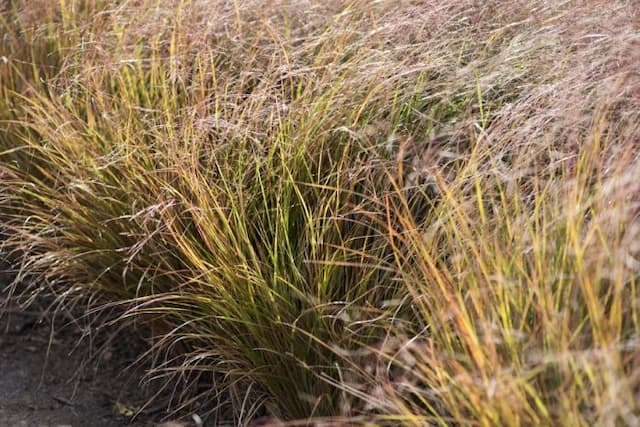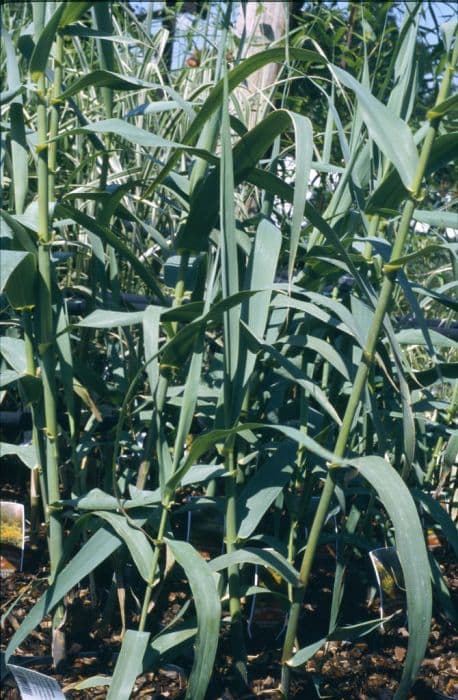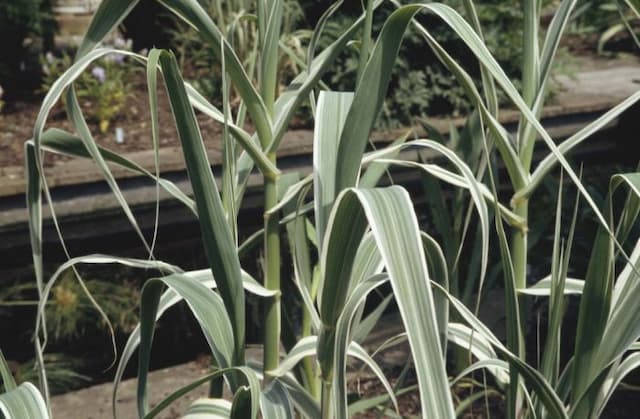Giant Feather Grass Stipa gigantea 'Gold Fontaene'

ABOUT
The plant known as the Giant Feather Grass or 'Gold Fontaene' is an ornamental grass that boasts a striking and elegant appearance. This grass is admired for its graceful arching foliage and impressive golden inflorescences that sway gently in the breeze, creating a shimmering effect. The leaves of the Giant Feather Grass are narrow and linear, presenting a soft green hue that can add a tranquil and natural feel to the garden landscape. During early to mid-summer, it produces tall, airy flower spikes that gradually turn from a purplish-green to a magnificent golden yellow as they mature, giving the plant its descriptive name 'Gold Fontaene'. These flower spikes are very fine and feathery, offering a delicate texture and a touch of whimsy to the garden setting. As the seeds develop, the plant maintains its aesthetic appeal well into the winter, with the dried flowering stalks catching the light and providing interest even in the colder months. The overall form of the Giant Feather Grass is flowing and fountain-like, creating a picturesque focal point in gardens where movement and a soft, naturalistic touch are desired.
About this plant
 Names
NamesSynonyms
Giant Feather Grass, Golden Oats
Common names
Celtica gigantea, Macrochloa gigantea, Stipa gigantea.
 Toxicity
ToxicityTo humans
Giant feather grass is not known for being toxic to humans. While generally considered non-poisonous, it is still advisable to avoid ingesting any part of ornamental plants as they are not intended for consumption and could potentially cause mild stomach upset or an allergic reaction in sensitive individuals.
To pets
Giant feather grass is not recognized as a toxic plant to pets. It does not contain known toxic compounds that would cause poisoning in animals. Nevertheless, ingestion of plant material by pets, especially in large quantities, may lead to gastrointestinal upset, such as vomiting or diarrhea, due to the plant's physical structure rather than its chemical makeup.
 Characteristics
CharacteristicsLife cycle
Perennials
Foliage type
Semi-deciduous
Color of leaves
Green
Flower color
Yellow
Height
6 feet (1.8 meters)
Spread
3 feet (0.9 meters)
Plant type
Grass
Hardiness zones
7
Native area
Southwest Europe
Benefits
 General Benefits
General Benefits- Ornamental Appeal: Giant Feather Grass features tall, elegant flower spikes that sway gracefully in the breeze, adding movement and texture to the garden.
- Drought Tolerance: Once established, it is drought-tolerant, making it suitable for dry or xeriscaped gardens.
- Low Maintenance: It requires minimal care once it is established, making it an excellent choice for gardeners seeking low-maintenance plants.
- Attracts Wildlife: The flowers of Giant Feather Grass attract pollinators, while the seeds may provide food for birds.
- Architectural Structure: The tall, upright form of Giant Feather Grass provides strong vertical lines in a garden design, offering architectural interest.
- Seasonal Interest: It provides visual interest throughout the seasons, from its flowering in summer to its golden-brown winter foliage.
- Easy Propagation: It can be easily propagated from seed or division, allowing gardeners to create more plants for use in other areas or to share.
- Soil Adaptability: It is adaptable to a variety of soil types, although it prefers well-drained soils.
- Long-Lived: As a perennial, Giant Feather Grass is a long-lived plant that can enhance a garden for many years.
- Complements Other Plants: Its fine texture contrasts well with broader-leaved plants, making it an excellent companion in mixed borders or meadow plantings.
 Medical Properties
Medical PropertiesThis plant is not used for medical purposes.
 Air-purifying Qualities
Air-purifying QualitiesThis plant is not specifically known for air purifying qualities.
 Other Uses
Other Uses- Acoustic Improvement: The dense foliage and tall structure of Giant Feather Grass can help dampen noise in a garden setting, making it a natural choice for urban gardens near busy streets.
- Photography Backdrop: The tall and elegant plumes of Giant Feather Grass can serve as a stunning backdrop for outdoor portraiture and nature photography.
- Seasonal Decoration: Dried plumes of the Giant Feather Grass can be used in floral arrangements or as standalone decorations for fall and winter, adding rustic charm to interior decor.
- Erosion Control: Planted on slopes or areas vulnerable to erosion, the extensive root system of Giant Feather Grass can help stabilize the soil and prevent erosion.
- Craft Material: The stems and plumes of the Giant Feather Grass can be woven or incorporated into craft projects, such as making bookmarks, greeting cards, or dream catchers.
- Children's Educational Tool: Teachers and parents can use parts of the Giant Feather Grass to teach children about plant life cycles, seed dispersal, and plant anatomy.
- Winter Garden Interest: With its plumes persisting through winter, Giant Feather Grass can add visual interest and texture to gardens that otherwise lack winter appeal.
- Festive Ornamentation: During holidays, the grass's plumes can be spray-painted and used as festive decorations or part of seasonal wreaths.
- Privacy Screening: When planted in rows or groups, Giant Feather Grass can create a semi-transparent screen, adding a sense of privacy to garden areas without a solid barrier.
- Wildlife Support: The seeds of Giant Feather Grass can provide food for birds, while its structure offers shelter to small animals and insects within a garden ecosystem.
Interesting Facts
 Feng Shui
Feng ShuiThe Giant Feather Grass is not used in Feng Shui practice.
 Zodiac Sign Compitability
Zodiac Sign CompitabilityThe Giant Feather Grass is not used in astrology practice.
 Plant Symbolism
Plant Symbolism- Growth - Stipa gigantea, commonly known as Giant Feather Grass, with its towering and lofty plumes, symbolizes continuous growth and reaching for higher aspirations.
- Elegance - The delicate and refined appearance of its feathery panicles epitomizes elegance and grace in the plant kingdom.
- Resilience - As a hardy and adaptable grass, Giant Feather Grass represents resilience and the ability to thrive in various conditions.
- Movement - The way its tall stems sway in the breeze represents fluidity and the importance of being flexible and adaptable to change.
 Water
WaterThe Giant Feather Grass should be watered deeply once a week, ensuring that the soil is thoroughly moistened. During periods of extended dry weather or intense heat, you may need to water it twice a week. It's essential to allow the soil to dry out between waterings to prevent root rot. An average of 1 to 1.5 gallons per watering should suffice, depending on the size of the plant and environmental conditions. Reduce watering frequency in the fall and winter when the plant's growth slows down.
 Light
LightGiant Feather Grass thrives in full sun, so choose a location where it can receive at least six hours of direct sunlight daily. It is adaptable to partial shade, but too much shade can result in weaker, less vigorous growth. The ideal spot is an open, sunny area away from tall trees or buildings that cast significant shadows.
 Temperature
TemperatureGiant Feather Grass is hardy in a range of temperatures but performs best when the daytime temperature is between 70°F and 80°F. It can tolerate temperatures as low as 20°F and as high as 90°F. This plant appreciates warmer summer temperatures and cooler winter periods, mimicking its natural growing conditions.
 Pruning
PruningPruning Giant Feather Grass is essential to maintain its shape and promote new growth. In late winter or early spring, before the new growth starts, cut back the foliage to about 6 inches from the ground. Pruning once a year during this time will help invigorate the plant and keep it looking tidy throughout the growing season.
 Cleaning
CleaningAs needed
 Soil
SoilThe Giant Feather Grass prefers a well-draining soil mix with a pH range between 6.0 and 7.5. A good mix can be achieved by combining loam, coarse sand, and organic compost. Ensure the soil allows for good drainage to prevent root rot, and avoid overly fertile soils that can cause floppy growth.
 Repotting
RepottingGiant Feather Grass, being an ornamental grass, generally does not require frequent repotting. It is typically repotted or divided every 3 to 5 years to rejuvenate the plant and prevent overcrowding, and ensure optimal growth conditions.
 Humidity & Misting
Humidity & MistingGiant Feather Grass thrives in average outdoor humidity levels and does not require any special humidity adjustments. This plant is quite adaptable and can tolerate a range of humidity conditions typical of outdoor environments.
 Suitable locations
Suitable locationsIndoor
Place in bright light, avoid high humidity, minimal water.
Outdoor
Full sun, well-draining soil, avoid overwatering, hardy.
Hardiness zone
7-10 USDA
 Life cycle
Life cycleGiant Feather Grass 'Gold Fontaene', also known simply as Stipa gigantea 'Gold Fontaene', begins its life as a seed that germinates in well-drained soil during the spring months under full sun exposure. As a perennial plant, it develops a basal clump of narrow, arching green leaves from which tall, slender flowering stems emerge, typically in late spring or early summer. The stems bear airy, oat-like flower panicles that start out silvery-green and mature to a golden hue, hence the name 'Gold Fontaene'. After the flowering phase and by late summer or fall, the plant sets seeds that can self-sow, continuing the cycle for the next season. During the winter, Giant Feather Grass becomes dormant, with the foliage often turning a tawny brown adding winter interest to the landscape. With the return of warmer temperatures in spring, new growth replaces the old, completing the cycle and beginning anew.
 Propogation
PropogationPropogation time
Early Spring
The most popular method of propagation for the Giant Feather Grass, commonly known as Stipa gigantea 'Gold Fontaene', is through division. The best time to divide this plant is in the spring, as new growth is beginning to show. To propagate by division, carefully dig up the plant, making sure to get as much of the root system as possible. Gently separate the plant into smaller sections, each with a portion of roots and shoots. You should then replant these sections at the same depth they were originally growing, and water them well. It is important that the soil is well-draining to prevent root rot. After division, the new plants should be kept moist until they are established, usually within a few weeks.









